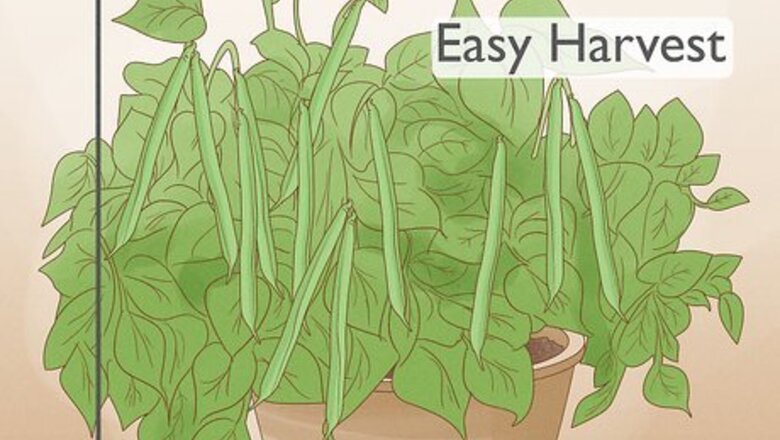
views
Selecting Beans and Readying the Soil
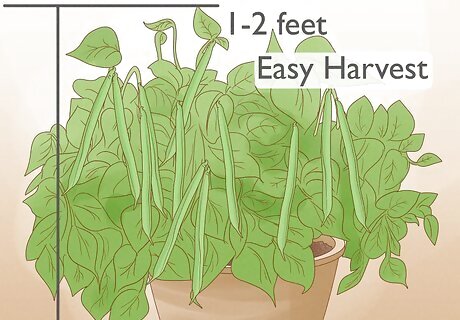
Plant bush beans for a reliable, easy harvest. The 2 basic green bean varieties are bush beans and pole beans. The bushes of bush beans spread out along the ground, and only grow to about 1–2 feet (0.30–0.61 m) high. While bush beans only tend to produce a single harvest during a growing season, they are relatively easy to grow and don't require much tending. Bush beans spread out horizontally while pole beans need to climb vertically. Bush beans do not need any sort of support in the garden, while pole beans require a trellis to climb. Recommended bush varieties for most regions include Bush Blue Lake and Bountiful.
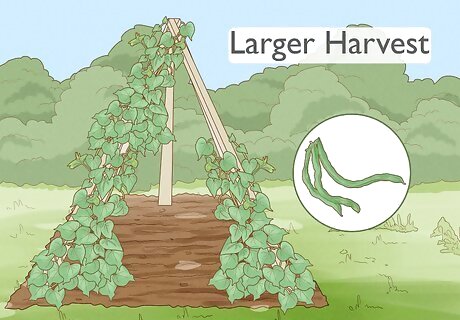
Plant pole beans for a quicker, larger harvest. Pole beans mature more quickly than bush beans do, which means that you'll be able to harvest pole beans sooner. They also grow beans continually during the growing season, so you'll get a larger number of beans from each individual plant than you would with bush beans. Recommended pole varieties for most regions include Fortex and Kentucky Wonder. Install a trellis for your pole beans to climb, such as a cattle panel, wooden lattice, or similar garden trellis.
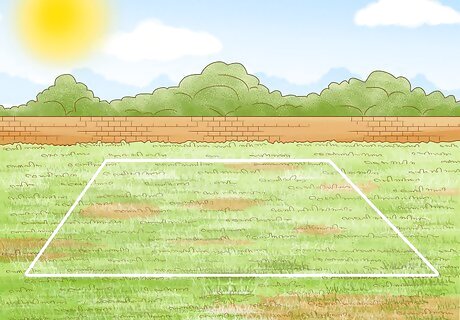
Pick a sunny spot to plant your crop. Green beans need plenty of sunlight to grow properly, so try to choose an area of your garden that receives full sun for your planting site. Since green beans do not do well in heavily-moist soil, you should avoid shaded locations, since shade tends to help soil retain moisture for prolonged periods.
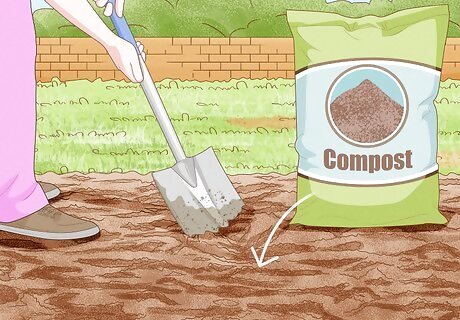
Amend the soil with compost until it has a loamy texture. Green beans thrive in loamy soil, so if your garden has heavy clay soil or sandy soil, you should amend it with organic material before planting your green beans. Loamy soil is dark and crumbly. Test the soil by squeezing it in your hands. Clay soil stays in a ball and sandy soil falls apart completely. Loamy soil will hold its shape initially yet break apart when touched. If working with clay-heavy soil, spread 2 inches (5.1 cm) of manure or compost over the soil and work it into the top 1 foot (30 cm) of soil using a shovel, garden fork, or rototiller. You could also mix sawdust or sand into the soil if it is especially heavy. If working with sandy soil, spread the same amount of heavy manure or compost into the soil in the same manner, but skip the sawdust. No matter what type of soil you have, you should also make sure that the area is free of weeds, trash, stones, and other debris.
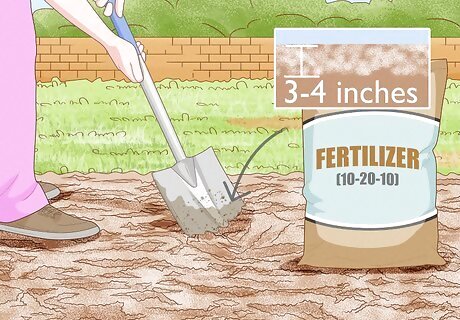
Apply a 10-20-10 fertilizer to the soil before planting the seeds. Green beans do not require a vast amount of nutrients, but a light application of fertilizer can help your plants produce a better crop. Use a shovel or trowel to mix the fertilizer into the top 3–4 inches (7.6–10.2 cm) of soil. 10-20-10 fertilizer is slightly richer in phosphorus than in nitrogen or potassium, so it is good for producing a strong crop yield. If you use a fertilizer high in nitrogen, then your plant will grow a lot of leaves but few beans.
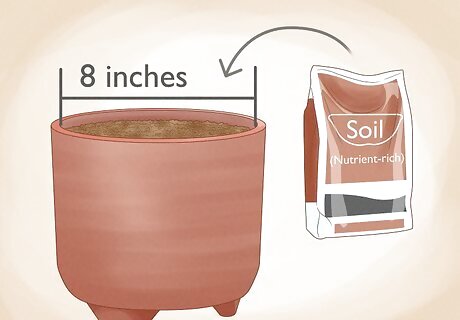
Grow them in a container if you'd rather not sow them in the ground. If you'd rather plant beans in a container or if you want to try growing beans indoors, you'll need to plant them in a reasonably large pot. Ideally, the container should be about 8 inches (20 cm) in diameter. Fill the pot with loose, nutrient-rich soil. If you're planting pole beans in a container, stick a trellis or lattice in the container as well, to allow the bean plants to grow. Since potted plants often dry out faster, you should check your soil moisture more often. You may need to water your green beans more if they're potted.
Planting the Green Beans
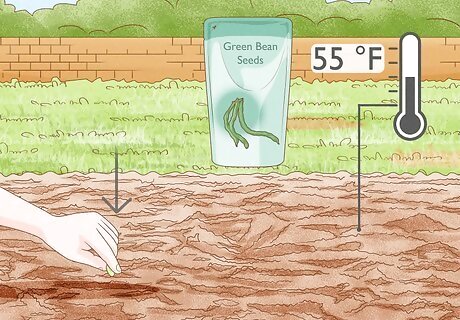
Sow the seeds outdoors after the last spring frost. The best soil temperature during the planting stage is 55 °F (13 °C). Ideally, the temperature should warm to 77 °F (25 °C) once the plants reach the emergence stage. The minimal soil temperature for green bean seeds is 48 °F (9 °C). If the soil temperature drops below this, even at night, the seeds may not germinate well, resulting in slow growth.
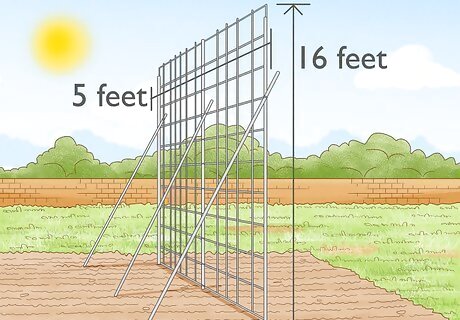
Set up a trellis if you're planting pole beans. A trellis or other fencing is not necessary if you are planting bush beans, but if you are going with a pole variety, growing the crop without some form of trellis will severely hinder the growth and yield of your plants. The simplest support you can provide for pole beans is a cattle panel. This is a small section of wire fence measuring about 16 feet (4.9 m) by 5 feet (1.5 m). Simply set up the fence behind your growing area before planting the seeds. You could also use a traditional pyramid trellis or a metal or plastic stake. Position either one just behind the planting location and make sure that the bottom 4 inches (10 cm) or so are underground.
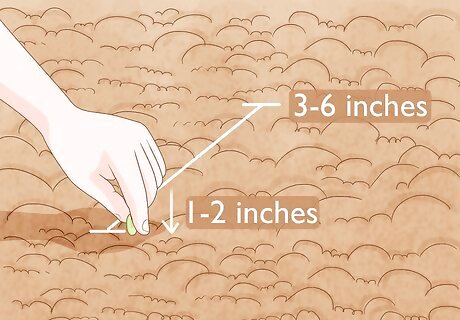
Plant each seed 1–2 inches (2.5–5.1 cm) deep in the ground. Each seed should also be about 3–6 inches (7.6–15.2 cm) apart and covered lightly with loose soil. If your soil is a little on the sandy side, plant the seeds a little deeper. If you're planting multiple rows of beans, leave 1–2 feet (0.30–0.61 m) of room between each row. Avoid soaking the seeds before planting or immediately after planting. When exposed to excessive moisture, green bean seeds have a tendency to crack and break.
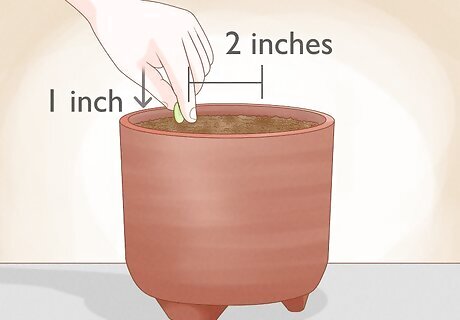
Plant the bean seeds 1 inch (2.5 cm) deep if you're using a container. Sow each seed roughly 2 inches (5.1 cm) apart. Use your fingers to press the individual seeds down into the soil. If you're planting pole beans, they'll need to be spaced out a little more. Plant pole bean seeds 4–6 inches (10–15 cm) apart. It's best not to start your seeds indoors, as green beans don't survive transplant well. Your seedlings likely won't thrive after transplanting.
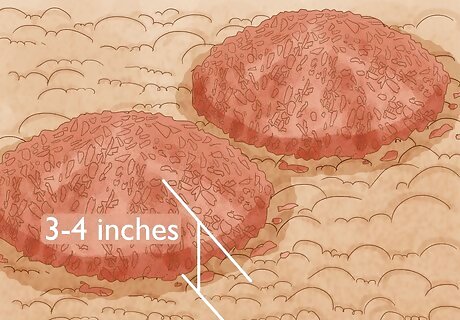
Apply mulch to the soil where beans are planted. Standard wood chip mulch or straw works well with green beans. Mulch can prevent the soil from getting too cool or too warm, and it also helps the soil retain moisture. Apply roughly 3–4 inches (7.6–10.2 cm) of mulch over the plants after the soil has started to warm up. Other good mulches include weathered straw and untreated lawn clippings. Make sure to use grass clippings that do not contain pesticides as mulch. Mulch can also help prevent the spread of weeds.
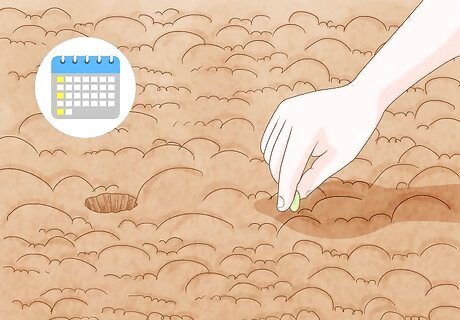
Sow additional seeds every 2 weeks. You can continue sowing green bean seeds every 2 weeks if you want a continual harvest that lasts all summer and into fall. Skip a planting if you plan to be gone with the green beans are ready to harvest. Note, however, that excessively hot weather may cause the plants to drop their blossoms and pods prematurely. If you live in a region known for particularly hot summers, you may need to put a stop to your green bean growing season during the hottest months.
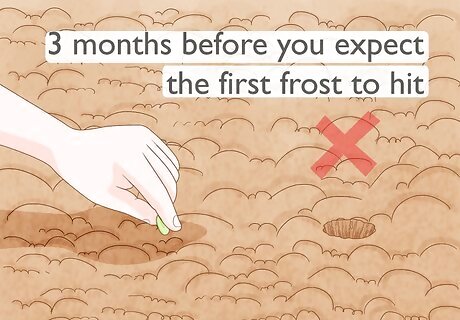
Stop planting new seeds 10 to 12 weeks before the first expected frost. For a final fall crop of green beans, you should sow the seeds roughly 3 months before you expect the first frost to hit. The time of your first frost will vary depending on the region you live in. If the first frost occurs before your final crop of green beans is ready to harvest, the buds or pods may drop prematurely. This is true even if the frost only occurs at night and the daytime temperatures are still within the ideal range.
Caring for Green Beans
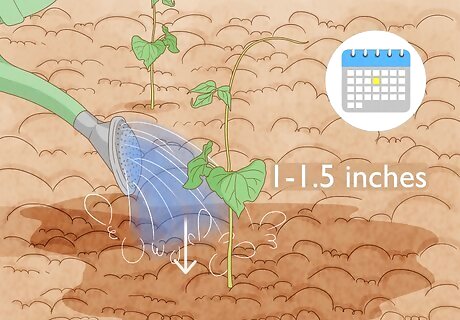
Water bean plants that are planted in your garden daily. Water plants in the morning and skip watering on cloudy or rainy days. Water on sunny days so that the moisture does not soak the foliage. Give the plants about 1–1.5 inches (2.5–3.8 cm) of water weekly. Later in the growth cycle, too much or too little water can cause the blossoms and pods to drop prematurely. It is best not to water your green bean plants during the middle of day as evaporation can occur.
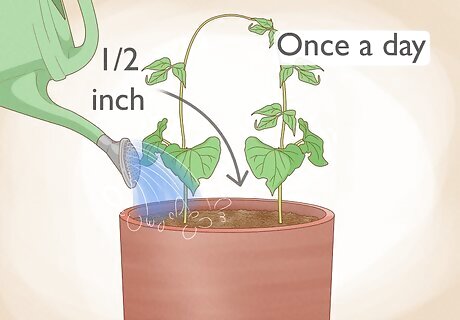
Water bean plants that are in containers once a day. Green bean plants grown in a container—whether indoors or outdoors—should be watered daily. Plants tend to need more than ⁄2 inch (1.3 cm) of water each week. Try to keep the soil moist, and give the plants extra water if you notice the soil beginning to dry out. If the soil is nutrient-rich (and not sandy or clayey), you shouldn't need to add fertilizer more than once a month.
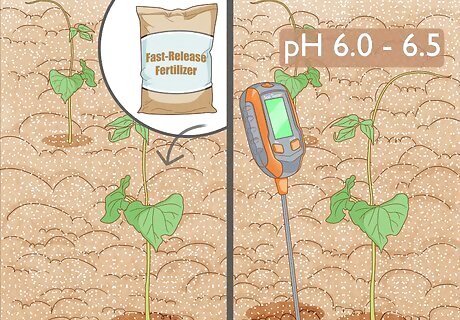
Apply balanced fertilizer sparingly. Green beans grow well with minimal nutrients, and applying too much fertilizer could actually cause an overabundance of foliage yet a small yield of actual green beans. As a general rule, you should only apply fertilizer if the nutrient levels of your soil are particularly low in a given area. If your soil is nutrient-deprived, you can fertilize the plants once a week with a light application of balanced, fast-release fertilizer. If your soil is somewhat on the sandy side, you might need to apply a fertilizer rich in nitrogen once the first seedlings form and once more once the plants reach their bud stage. Green beans prefer soils with a pH between 6.0 and 6.5. If your soil is especially acidic or basic, you might need to apply fertilizers formulated to balance the soil pH.
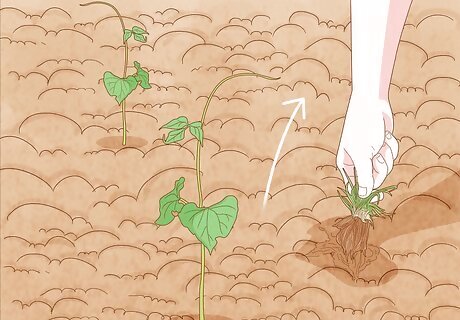
Remove weeds as needed. Weeds can choke out green beans, making it difficult for them to emerge from the surface and strangling them once they do. Remove weeds as soon as you spot them to ensure a good crop of green beans. When removing weeds, do not dig too deep. Green beans have shallow roots, and digging too deep into the soil can cause damage to these roots. Do not weed when the foliage is wet, since doing so would increase the risk of disease.
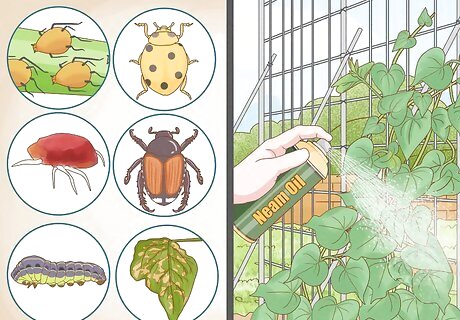
Watch out for pests and diseases. There are a few pests and diseases that green beans commonly fall victim to. Treat the plants with organic insecticides and fungicides as needed to keep these problems under control. Neem oil and sulfur are usually adequate fungicides. Green beans are especially attractive to aphids, mites, cutworms, Mexican bean beetles, and Japanese beetles, and are especially weak against white mold and mosaic viruses. Get rid of cutworms with a Bacillus thuringiensis insecticide. Get rid of aphids and mites by hosing them off your leaves with a hard burst of water.
Harvesting and Storage
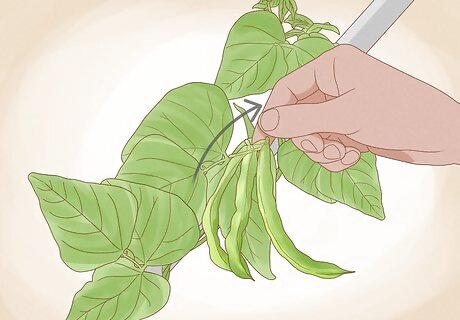
Pick the green beans during an immature stage. The pods should be firm, and you should be able to snap them off the plant without tearing the stems. Green beans are usually about the size of a small pencil when ready to harvest. Harvest usually takes place 50 to 60 days from planting and 15 to 18 days after the full bloom stage. If the beans are given more time to mature, the pods will become more stringy and develop a tough outer skin. Note that the seeds inside should not be allowed to fully develop. At a fully developed, mature stage, the inner seeds will turn hard.

Harvest the beans from container-grown plants once the pods start to bulge. This is a reliable visual signal that the beans are mature. In general, the beans will be mature and ready to harvest between 45 and 75 days after they're planted. If you harvest the beans before they've fully matured and become stringy, your bean plants may produce a second harvest.
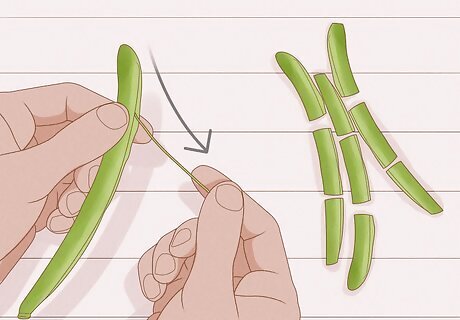
Break and string the harvested beans. Bring the harvested beans into your kitchen, and fill a large pot with water. Snap the tip off of each green bean, and remove the long string from the front side of the bean. Then, snap each bean into 2 or 3 separate pieces. Drop the broken beans into the pot of water to rinse the dirt off of them. If you prefer your green beans whole, you can skip the breaking step. It's still best to string the beans shortly after they are harvested, though.
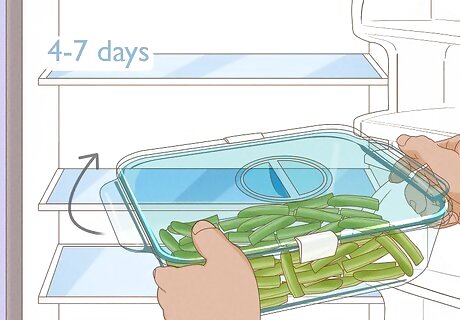
Store the green beans in a refrigerator. Keep harvested green beans in an airtight container and store for about 4 to 7 days in your refrigerator. Freeze, can, or pickle green beans for long-term storage. The beans can be kept in the freezer for 3–6 months.




















Comments
0 comment